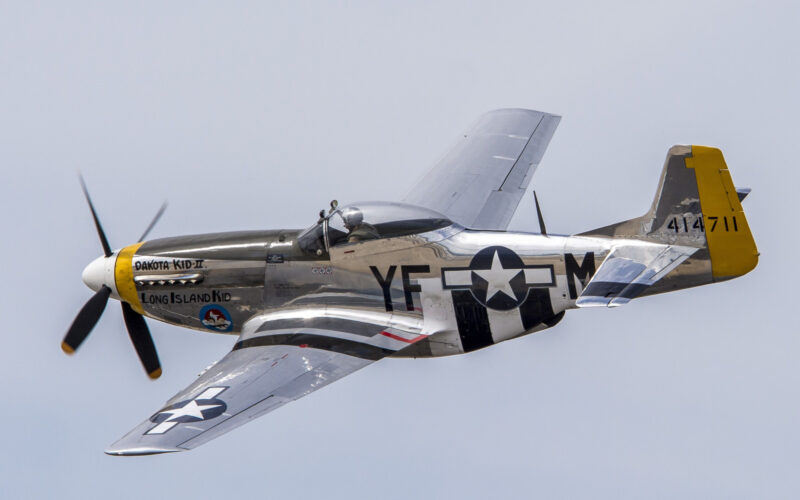The North American P-51 Mustang, a legendary fighter plane, holds an indelible place in aviation history as one of the most iconic and influential aircraft ever built. Developed during World War II, it quickly gained a solid reputation for its remarkable performance, versatility and distinctive design.
Let’s look at the fascinating history of the P-51 Mustang, exploring its variants, role, technical characteristics, orders and deliveries and commercialization.
Origins and development of P-51
The origins of the P-51 Mustang can be traced back to a request from the British Purchasing Commission in 1940, indicating their interest in acquiring an American aircraft. Seeking advanced fighters, they sought American manufacturers to create high-altitude, long-range aircraft.
Rather than continuing the production of the older Curtiss P-40 fighters under license, North American Aviation took a forward-thinking approach. They proposed to pivot away from the replication of antiquated designs, advocating instead for the conceptualization and manufacturing of a more innovative model – the P-51 Mustang.
The North American Aviation design team developed the initial version of the P-51 Mustang, a trim low-wing monoplane, equipped with an Allison V-1710 engine. However, it was the incorporation of the British Rolls-Royce Merlin engine into later versions that truly transformed the aircraft into a formidable machine and led to its exceptional performance.
The P-51 Mustang was designed as a single-seat aircraft, accommodating only one pilot.
The prototype, known as NA-73X, was first unveiled on September 9, 1940, and it completed its inaugural flight later that year, on October 26, 1940.
Dominating the skies
The P-51 Mustang played a vital role in various theaters of World War II as well as the Korean War. It was initially designed as a long-range bomber escort, at which it excelled, providing crucial protection for Allied bombers on missions deep into enemy territory. Its ability to accompany bombers for extended distances and engage enemy fighters in dogfights made it a formidable adversary. The P-51 also proved highly effective in ground attack and reconnaissance missions, showcasing its versatility.

Commercialization: beyond military service
After World War II, surplus P-51 Mustangs were sold to private buyers and in various countries, contributing to its commercialization. During the period of the war, a Mustang was priced at approximately $51,000. However, in the period following the war, hundreds of these aircraft were essentially given away, for the token price of one dollar, to nations that signed the Inter-American Treaty of Reciprocal Assistance, which was ratified in Rio de Janeiro in 1947.
The aircraft found new roles beyond military service, such as air racing, aerobatics, and even aerial firefighting. The enduring popularity of the Mustang led to the establishing of restoration projects and the production of replica aircraft such as the Titan P-51 Mustang, Thunder Mustang, and more, allowing aviation enthusiasts to experience the thrill of flying this legendary machine.
Orders and deliveries
During its production run from 1940 to 1946, over 15,000 P-51 Mustangs were manufactured. The aircraft saw service in numerous air forces around the world, with the United States, United Kingdom and Canada being the primary users. The Mustang’s reputation for reliability, performance and combat effectiveness led to significant orders and widespread deployment, cementing its place in aviation history.
After World War II, over 25 nations incorporated the P-51 Mustang into their air forces.
Variants: evolving perfection
While it was in production, the P-51 Mustang went through numerous noteworthy variants, each enhancing the design and performance of the preceding model. From 1940 onwards and extending beyond the end of the war, more than 20 different variants of the P-51 Mustang were manufactured.
The most noteworthy variants were:
- P-51A, of which 310 units were manufactured
- P-51B, with a total production of 1,987 units
- P-51C, having 1,750 units produced
- P-51D, with an impressive 8,200 units built
- P-51H, with a build count of 555 units
- P-51K, of which 1,500 units were built
In particular, the P-51D became the most widely produced and recognized variant, featuring a bubble canopy for improved visibility and the ability to carry a heavy payload of bombs or rockets.

Technical characteristics of P-51 Mustang: power, speed, and maneuverability
The P-51 Mustang boasted impressive technical characteristics that set it apart from its contemporaries.
Equipped with a powerful Rolls-Royce Merlin engine, it had exceptional speed and altitude capabilities. Its maximum speed exceeded 400 miles per hour (640 kilometers per hour), and it could reach altitudes of over 40,000 feet (12,000 meters). The Mustang’s agile maneuverability made it a nimble and lethal opponent in aerial combat.
The P-51D Mustang was also equipped to carry six 12.7 mm AN/M2 Browning machine guns, a payload of 450 kg of bombs, and either six or ten 127 mm T64 H.V.A.R rockets.
| Technical Characteristics | Specifications of P-51D Mustang |
| Role | Fighter and Escort Aircraft |
| Powerplant/Thrust | 1x Packard (Rolls Royce) V-1650-7 Merlin Piston/Thrust 1,490 horsepower (hp) (1,110 kW) at 3,000 revolutions per minute, 1,720 hp (1,280 kW) at war emergency power |
| Max Speed | 440 mph (710 km/h) |
| Range | 1,650 miles (2,660 km) |
| Service Ceiling | 41,900 ft (12,800 m) |
| Rate of Climb | 3,200 ft/min (16 m/s) |
| Length | 32 ft 3 in (9.83 m) |
| Wingspan | 37 ft (11.28 m) |
| Height | 13 ft 4.5 in (4.077 m) |
| Max Payload | 2,006 lb (910 kg) |
| Maximum Takeoff Weight | 12,100 lb (5,488 kg) |

